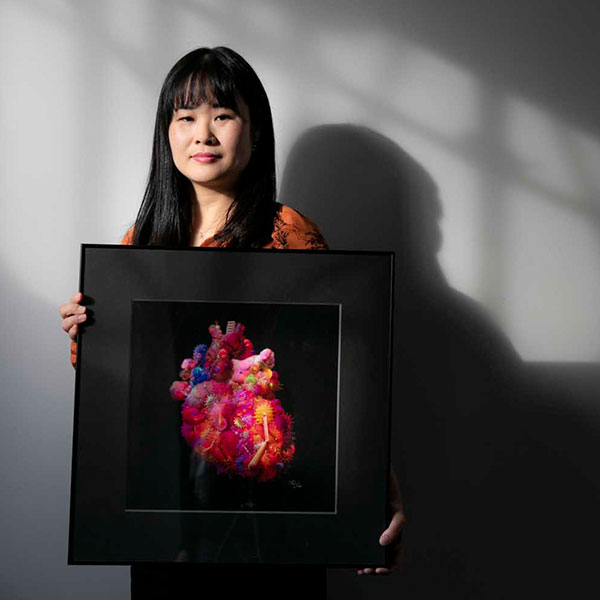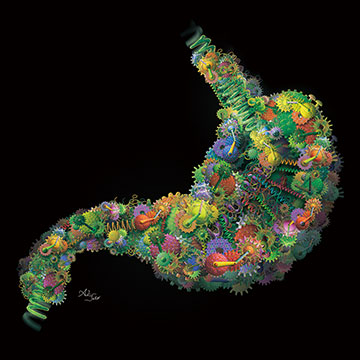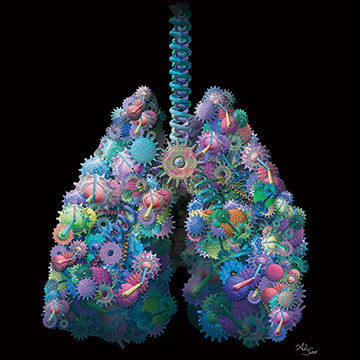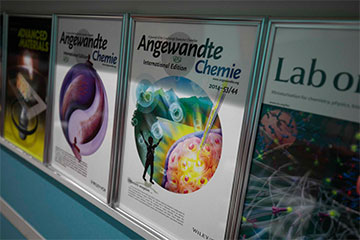A laboratory-affiliated computer graphics artist fusing art and science

UTokyo artists in the spotlight
A research associate, a graduate student, a former company employee and a graduate...
Among the many people deeply involved with the University of Tokyo, we introduce four artists who are carrying on creative activities worthy of notice.
A laboratory-affiliated computer graphics artist fusing art and science
| Akiko Sato Project Researcher, Institute of Industrial Science http://www.hybrid.iis.u-tokyo.ac.jp/en/akisato |

Photo: Junichi Kaizuka
The Shoji Takeuchi Biohybrid System Laboratory, gathering attention for its biohybrid studies such as robots made by fusing muscles and mechanisms, has its own affiliated artist. She is a project researcher in charge of graphics for conveying research results in readily understood forms, from figures and video to posters and even logos. After graduating from the Joshibi University of Art and Design, Sato worked for a digital production company, helping to create TV programs and videos and working on ads for fashion brands and others. While her daily work as a computer graphics designer was fulfilling, she came to the point of feeling she had exhausted the potential of that job, and went back to Joshibi as a research associate in the Department of Media Art. One day, when her work took her to the Hongo-sanchome subway station in Tokyo, a poster for a lecture event caught her eye.
“I was fascinated by the theme of ‘Biomedia Art,’ which was new to me, and since the timing was just right, I decided to drop by for the lecture. As it turned out, the lecturer was Professor Takeuchi. I’ll never forget the images of insect legs attached to an electronic circuit board and being made to move artificially by an electrical current…”
Moved to action by that intense experience, Sato looked up the lab and visited a few days later with samples of her work in hand. Well aware of the importance of PR, Takeuchi lobbied hard with the University, and after various twists and turns, a laboratory-affiliated artist was born at UTokyo for the first time ever.
When it came to science, however, she was a rank amateur. Many of the terms used in the lab – “in vitro” “liposome” “contami[nation]” – were unintelligible. A feeling of inferiority initially made her hold back. For conveying science to the public, however, she came to see this lack of understanding as a weapon. She went forward with her work while repeatedly asking questions. One day, a researcher looked at Sato’s drawing and earnestly said, “So this is what I was trying to say,” making her confident that her efforts had meaning.
“There are times when even scientists can’t quite grasp their own research work. The power of art is making this visible. That’s my job. Now that I’ve been doing this for nearly nine years, I feel that Takeuchi and I are on the same wavelength, enabling me to come up with an image of the research. Lately, I’ve been telling researchers that ‘If I don’t understand the research, it won’t make the cover of an academic journal.’”
Two things Sato wishes are to increase the number of art school graduates in the sciences, and for researchers to learn graphical expression. This laboratory where mechanical devices and life forms are fused together is also attempting to merge art and science.



* This article was originally printed in Tansei 38 (Japanese language only). All information in this article is as of March 2019.






